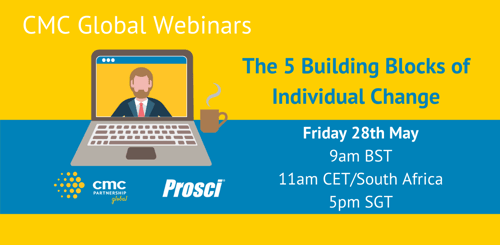How to ensure successful implementation of change? For many organisations timescales and budgets are the two primary factors that determine the successful implementation of a project. The growing recognition of the importance of enterprise change management is causing a shift in this analysis approach, incorporating increasingly more dynamic factors.
The role of the individual in the overall change process is one such factor that is gaining increasing consideration. As after all, while a new tool can be implemented on schedule and on budget it does not automatically begin generating value for an organisation until it becomes adopted and individuals begin to use it with the required level of proficiency.
This is the same for any organisational change initiative that impacts the way employees perform their roles. The true value of a new process or system can only be realised when a specific majority of directly impacted individuals are capable of and have made their own successful personal transition. An incomplete change from the individuals affected does not only prevent the realisation of the whole value but can also become seriously detrimental to the operational performance of the organisation as a whole. The end result is lower than expected.
To put it concisely, organisations themselves do not change, the people within them do.
The link between any strategy, process or systems change and the associated business results is the collection of individual changes that occur one person at a time.
Understanding how to achieve change at an individual level, therefore, is essential to achieving the objectives of any large-scale change.
Download: Prosci ADKAR® Model: Complete eBook
The risks of not having an individual perspective of change management
With the growing recognition for enterprise change management the need to understand the change management capabilities of the organisation as whole are evident but without a solid understanding of how individuals perceive and succeed in changing there are a number of associated risks.
One of the biggest risks is the idea that the implementation process of enterprise change management is ‘recipe-driven’: a list of actions or requirements that can be simply checked off. As it is important that each and every individual achieves a successful change in behaviour and/or attitudes, focus must be given to the progress of every employee in their transition and this requires continuous measurement.
Increased communication, although one particular indicator of enterprise change management capabilities, does not ensure an organisation can expect to send X-amount of emails about a change and not face any resistance; these emails must also contain considerations of the individual and indeed emails may not be an individual’s preferred method of receiving messages. Increasing communications activities in an unplanned, unstructured and intangible way is evidence of an organisation ‘doing’ change management without including a focus of what they were trying to achieve or why.
The next biggest consequence of not giving consideration to individual change management is the increasing difficulty in determining when success has been achieved. Time scales and budget are success factors of project implementation; but determining how successful the people side of the change has been, requires consideration of what is expected from each individual in order to generate the true value of a project; ensuring real acceptance, adoption of new ways of working with measurable proficiency.
Webinar: The Five Building Blocks of Individual Change, Friday 28th May
Linking individual performance to enterprise change management and business results
Developing enterprise change management capabilities requires consideration of individual change management. But to do so in a manner that is effective, consistent and most important replicable across the entirety of the organisation requires consideration. According to Prosci’s Best Practices Research study only 40% of organisations actively measured the effectiveness of their change management activities. Developed by Jeff Hiatt from a survey of over 600 organisations, the founder of Prosci, the Prosci ADKAR® model outlines the five outcomes that an individual must first experience before organisations can change.
This building block model and the insights it provides give a unique perspective on the requirements of an individual if they are to successfully to progress through a change they are being impacted by.
- Awareness of the need for change
- Desire to support and participate in change
- Knowledge of how to change
- Ability to implement change
- Reinforcement to sustain change
The Prosci ADKAR® model creates an outline of the most basic elements needed for an individual to successfully achieve and sustain a change and in a sequence that, by nature, cannot be skipped or reordered.
With this framework the link between individual performance, enterprise change management and business results can be established, measured and effectively managed.
By using the Prosci ADKAR® model as a framework for individual change management, enterprise change management models can be applied more effectively and deliberately, increasing the chance of organisational success.
Learn More
Successful change is rooted in how to facilitate change with one person. In our upcoming webinar on May 28th, we will learn about the foundation and universal application of ADKAR and focus on unlocking individual barriers to change through Awareness, Desire, Knowledge, Ability and Reinforcement. Register here.


